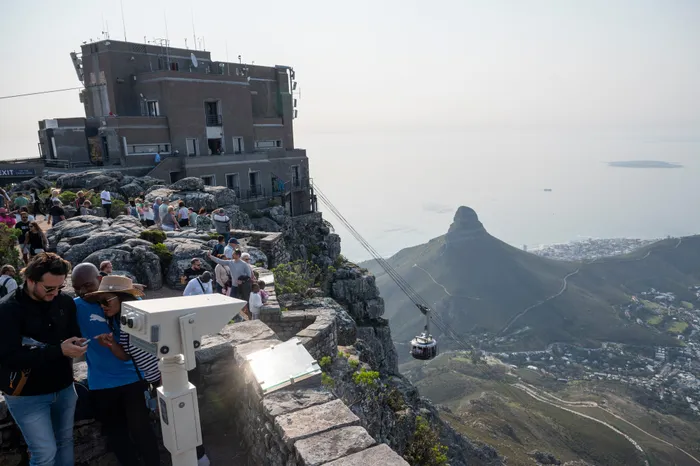Strategic ‘tourism distribution’ can benefit its growth in SA

Table Mountain is a much-loved tourism spot. Photographer: Armand Hough / Independent Newspapers
By Sabine Lehmann
In South Africa, tourism contributes a significant 3.7% towards the country’s GDP and creates 770 000 direct jobs (pre-pandemic figures), while beyond this economic impact, it also offers personal enrichment, opportunities to rest and recharge, connect with strangers and friends, and engage in new experiences, whether we seek physical or mental adventures.
However, the problem of over-tourism cannot be ignored. In several destinations, particularly in Europe and parts of Asia, tourism no longer feels beneficial, with locals feeling squeezed out of their neighbourhoods and overrun by strangers.
For these communities, the benefits of tourism are overshadowed by its costs, leading to questions about what there is to celebrate during Tourism Month.
Australia’s Great Barrier Reef, for example, sees 86% of its 1.8 million annual visitors concentrated in just two regions, which have a year-round population of only 130 000. While increasing tourism infrastructure may be seen as the answer, infrastructure projects often lag behind tourism growth, and large projects such as airports, roads and hotels require funding and have an impact on the environment.
In South Africa we are not at a point where over-tourism is a problem, though there are times – for instance, during the December school holidays – when popular destinations such as the Kruger National Park and Table Mountain experience tourism pressure.
A recent study by consultants McKinsey & Company cautions that Cape Town is starting to show “risks from concentrated tourism”, with overloaded tourism infrastructure beginning to impact the visitor experience.
How do we stay ahead of the curve and ensure that tourism, both domestic and international, is a net benefit in its full socio- economic sense? There is a need to manage the physical and mental pressure that a large influx of tourism brings, but finding a balance between residents, visitors and businesses is not always easy.
Tourism distribution – how and when tourists are spread out across destinations – will become a crucial skill for destination management organisations, and requires a multi-stakeholder effort. Tourism flows and the spatial distribution of tourists will be the future skill required to ensure a fit-for-purpose tourism economy that serves and benefits the widest set of South Africans in the next decade.
Strategies to support tourism distribution
There are several levers that can enhance tourism distribution, benefiting the host destination, local businesses and citizens.
Stagger school holidays
Flattening seasonality by staggering school holidays, particularly the summer holidays, could extend the domestic tourism season, thereby supporting the industry throughout the year. This approach would distribute demand for accommodation, flights and other services over a longer period, reducing costs for travellers and sustaining tourism jobs. Seasonality for all in the tourism industry could be significantly increased by staggering coastal and inland holidays. Even a one-week shift could significantly impact the industry.
Matching demand to supply
Ideally, the aim is to match the demand for tourism products with the supply of tourism products. There is not a uniform demand for tourism products throughout the year, or even the day. For example, the first week in December and the last week of January are traditionally quieter. Equally, there is higher demand for Table Mountain Cableway tickets in the mornings than towards the end of the day. Similarly, the Cango Caves experience high demand mid-morning compared to other times throughout the day.
Shifting 10 -15% of the demand away from peak times of the day would create not only a better experience for the visitor, but also solve infrastructure and staffing problems that are all concentrated at the peak time periods. Here, dynamic pricing – a strategy already used by airlines, and extending to hotels, car hire and tourist attractions – can spread demand away from peak times, offering lower fees during off-peak periods, and enhancing the visitor experience while easing the pressure on infrastructure and staff.
Responsible tourism
We all have a duty to be responsible tourists. By exploring less-visited places or visiting popular sites during off-peak hours and seasons, we can help reduce congestion. For example, while the midday rush makes Cape Point and Boulders Beach crowded, visiting these sites early in the morning or late in the afternoon can provide a far better experience.
Develop new markets and new products to support tourism spread
Expanding into new markets and innovative tourism products can also support the distribution of tourism more evenly. Focus on targeting source markets that travel outside of our traditional summer period. South Africa has a unique opportunity to manage this spread as our peak safari season is counter to our peak summer season. Alternatively, by promoting alternative experiences and products, such as astro-tourism, for example, in areas with dark skies, one can shift the demand away from overburdened destinations.

Sabine Lehmann is the director of CURIOSITAS and has an MPhil in Futures Studies from Stellenbosch Business School.
BUSINESS REPORT